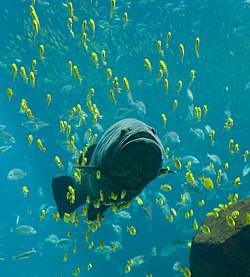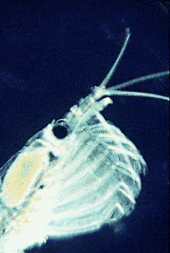Aquatic feeding mechanisms

Aquatic feeding mechanisms face a special difficulty as compared to feeding on land, because the density of water is about the same as that of the prey, so the prey tends to be pushed away when the mouth is closed. This problem was first identified by
Most underwater predators combine more than one of these basic principles. For example, a typical generalized predator, such as the cod, combines suction with some amount of protrusion and pivot feeding.
Suction feeding
| External videos | |
|---|---|
Suction feeding is a method of ingesting a prey item in fluids by sucking the prey into the predator's mouth. It is a highly coordinated behavior achieved by the dorsal rotation of the dermatocranium, lateral expansion of the suspensorium, and the depression of the lower jaw and hyoid.[2] Suction feeding leads to successful prey capture through rapid movements creating a drop in pressure in the buccal cavity causing the water in front of the mouth to rush into the oral cavity,[3] entrapping the prey in this flow. This mode of feeding has two main phases: expansion and compression.[2] The expansion phase involves the initial opening of the jaws to capture prey. These movements during the expansion phase are similar across all suction feeders with the kinesis of the skull leading to slight variations. During the compression phase the jaws close and water is compressed out of the gills.
Though suction feeding can be seen across fish species, those with more cranial kinesis show an increase in suction potential as a result of more complex skull linkages that allow greater expansion of the buccal cavity and thereby create a greater negative pressure. Most commonly, this is achieved by increasing the lateral expansion of the skull. In addition, the derived trait of anterior protrusion via the premaxillary bone in the upper jaw is acknowledged to increase the force exerted on the prey to be engulfed.[4] Protrusible jaws via a mobile premaxilla can only be seen in fishes within the teleostei clade.[2] However, a common misconception of these fishes is that suction feeding is the only or primary method employed.[5] In Micropterus salmoides, ram feeding is the primary method for prey capture; however, they can modulate between the two methods or use both as with many teleosts.[5][6] Also, it is commonly thought that fishes with more primitive characteristics also exhibit suction feeding. Although suction may be created upon the mouth opening in such fishes, the criteria for pure suction feeding includes little or no bodily movement towards their prey.[2]
Tradeoffs
The morphologies and behaviors during suction feeding have led to three main proposed tradeoffs that determine the success of prey capture:
The third main tradeoff within suction feeding occurs with the incorporation of ram feeding with suction feeding behaviors. Ram feeding involves movement of the predator with its mouth open to engulf the prey.[6] Most species use ram feeding combined with suction feeding to increase the chances of capturing elusive prey[6] by swimming towards their prey while using suction to draw prey into the mouth. This diversity in relative use is quantified using the Ram Suction Index (RSI) that calculates the ratio of use for ram and suction during prey capture.[6] The RSI ratio can be influenced by the morphology of the predator and by the elusiveness of the prey. Ram feeding and suction feeding are on opposite sides of the feeding spectrum, where extreme ram feeding is when a predator swims over an immobile prey item with open jaws to engulf the prey. Extreme suction feeding is demonstrated by sit-and-wait predators that rely on rapid depression of the jaws to capture prey (e.g. frogfish, Antennariidae). There is wide diversity on how much of each feeding strategy an individual uses, especially when body ram movements are considered.[17] The relative use of ram and suction feeding is species dependent, but it can help determine the accuracy of prey capture.[18]
The mouth aperture represents another tradeoff between the ability to capture large elusive prey with more chances of failure—large gape—or to capture smaller elusive prey with greater success—smaller gape. A predator with a small mouth aperture can generate strong suction force compared to an individual with a wider gape.[19][18] This was demonstrated by Wainwright et al. (2007) by comparing the feeding success of the bluegill sunfish, Lepomis macrochirus, and the largemouth bass, Micropterus salmoides. L. macrochirus has a smaller gape and was found to have higher accuracy with higher flow velocity and acceleration while M. salmoides has a larger gape with lower accuracy and lower flow velocity and acceleration.[18] However, with the larger gape the largemouth bass were able to capture larger elusive prey. Using ram feeding in combination with suction feeding can also influence the direction of water into the mouth of the predator. With use of ram, predators are able to change the flow of water around the mouth and focus the flow of water into the mouth.[20] But with too much ram, a bow wave is created in front of the predator which can push the prey away from the predator's body.[20] The mouth aperture and RSI represent the overall tradeoff between having a large gape with lower accuracy but being able to capture larger prey vs. having a smaller gape with increased accuracy but the size of prey is limited. The three main tradeoffs within the fish skull have occurred because of the high kinesis in the skull and the elusiveness of some prey types. However, having kinesis in the skull can enable a predator to evolve new techniques on increasing the performance of prey capture.
Ram feeding
Ram feeding is a method of feeding underwater in which the predator moves forward with its mouth open, engulfing the prey along with the water surrounding it. During ram feeding, the prey remains fixed in space, and the predator moves its jaws past the prey to capture it. The motion of the head may induce a
-
ForagingMobula alfredi ram-feeding, swimming against the tidal current with its mouth open and sieving zooplankton from the water[23]
-
macroplankton
Lunge feeding

Jaw protrusion
| External videos | |
|---|---|
Jaw protrusion is the outward movement of the
Another example of protrusion is seen in
Pivot feeding
Pivot feeding is a method to transport the mouth towards the prey by an upward turning of the head, which is pivoting on the neck joint.
The secret of the speed of pivot feeding is in a
Filter versus suspension feeding

These are contrasting methods for the removal of food particles from a water flow: for example, by the
Filter feeding
In
Suspension feeding
In suspension feeding, the water flow is primarily external and the particles themselves move with respect to the ambient water flow, such as in
See also
- Cleaner fish
- Feeding behaviour of fish
- Lepidophagy
- List of feeding behaviours
- Paedophagy
References
- OCLC 456355.
- ^ ISSN 0003-1569.
- S2CID 26805223.
- PMID 18544504.
- ^ PMID 22285791.
- ^ ISSN 0022-0949.
- S2CID 150135750
- ^ PMID 21676723.
- PMID 16519241.
- ^ PMID 22855615.
- ISSN 0024-4066.
- S2CID 24315046.
- ^ from the original on 2020-07-21. Retrieved 2020-09-06.
- S2CID 17433961.
- ^ Durie, C.J.; Turingan, R. (2001). "Relationship between durophagy and feeding biomechanics in gray triggerfish, Balistes capriscus: intraspecific variation in ecological morphology". Florida Scientist. 64: 20–28.
- ISBN 9780123504470
- PMID 26596534.
- ^ PMID 21672823.
- S2CID 4996900.
- ^ PMID 16000535.
- .
- PMID 19828500.
- PMID 23056255.
- ^ S2CID 17923052.
- PMID 19158011.
- PMID 8927640.
- ^ Gonzalez, Robbie (13 November 2014). "What Do This Dragonfly's Prehensile Mouthparts Have To Do With Its Anus?". Gizmodo. Archived from the original on 2021-07-09. Retrieved 2021-07-03.
- PMID 17251161.
- ^ Langley, Liz (26 November 2013). "Why Does the Seahorse Have Its Odd Head? Mystery Solved". National Geographic Society. Archived from the original on 26 July 2020. Retrieved 25 May 2020.
- S2CID 205321320.
External links
- FishBase is a comprehensive database of bony fishes: /fishbase.org

![Foraging Mobula alfredi ram-feeding, swimming against the tidal current with its mouth open and sieving zooplankton from the water[23]](http://upload.wikimedia.org/wikipedia/commons/thumb/3/33/Manta_alfredi_ram_feeding.png/193px-Manta_alfredi_ram_feeding.png)


![Seahorses rely on stealth to ambush small prey such as copepods. They use pivot feeding to catch the copepod, which involves rotating their snout at high speed and then sucking in the copepod.[29][30]](http://upload.wikimedia.org/wikipedia/commons/thumb/d/dd/Black_Sea_fauna_Seahorse.JPG/192px-Black_Sea_fauna_Seahorse.JPG)
